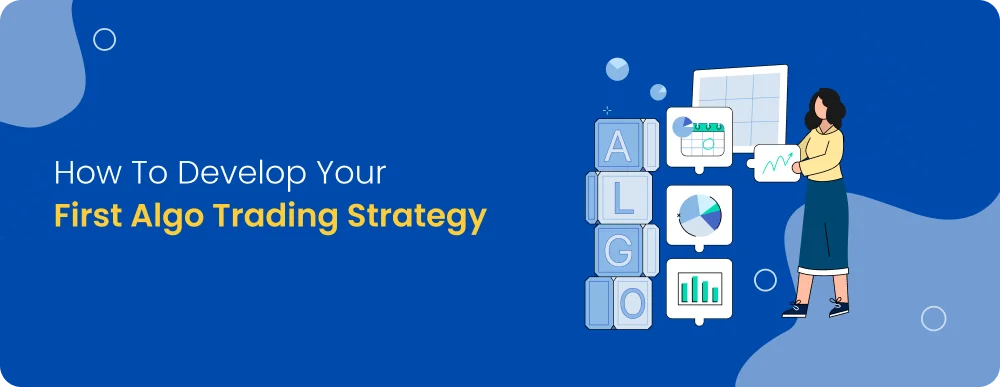How to Develop Your First Algo Trading Strategy
Noor Kaur
24 Feb 2025Tags:
Featured
Developing your first algo trading strategy requires a structured approach — you must define your trading strategy, select technical indicators, and implement risk management rules. Also, backtesting helps refine your algo strategy, ensuring it performs well before live trading. Read along to know more!
Understanding Algorithmic Trading and Its Benefits
Algorithmic trading (algo trading strategy) uses pre-programmed rules to execute trades automatically. It eliminates emotional trading and helps you follow a structured trading strategy. Some benefits of this include:
- Speed and efficiency: Executes trades faster than manual trading.
- Reduced human error: Removes impulsive decisions.
- Backtesting capabilities: Allows you to test your algo strategy with historical data.
- Scalability: Helps manage multiple futures trading strategies or day trading strategies simultaneously.
Key Components for Developing an Algo Trading Strategy
To build an effective algo trading strategy, focus on:
- Market analysis: Use technical and fundamental analysis to define your trading strategy.
- Indicator selection: Choose tools like moving averages or Bollinger Bands for trade signals.
- Risk management: Set stop-loss and position-sizing rules to protect capital.
- Backtesting: Test your algo strategy on historical data before live trading.
Choosing the Right Asset Class for Your Strategy
Selecting an asset class depends on your trading style and risk appetite. Options include:
- Stocks: Best for long-term and day trading strategies.
- Forex (foreign exchange market: Suitable for high-frequency trading.
- Futures: Common in futures trading strategies due to leverage.
- Cryptocurrency: Volatile but offers unique trading opportunities.
Suggested Read: Intraday Trading Strategy: Open High Open Low Approach
Essential Tools and Platforms for Algo Trading
To implement your algo trading strategy, you need:
- Programming languages: Python, C++, or Java for coding your strategy.
- Trading platforms: Use software such as Mastertrust for execution.
- Market data providers: Access to real-time data for accurate algo trading tips.
- Backtesting tools: Software like Mastertrust to refine your algo strategy before live trading.
Steps to Developing Your Algo Trading Strategy
Creating an algo trading strategy requires careful planning and testing. You need a clear trading strategy, the right technical indicators, and a strong risk management plan. Whether you're working on futures trading strategies or day trading strategies, follow this structured approach to improve decision-making:
1. Defining Your Trading Goals
Start by setting clear objectives. Are you focusing on day trading strategies for short-term gains, or do you prefer futures trading strategies for leveraged positions? Define your risk tolerance, expected returns, and market conditions that align with your algo strategy.
2. Selecting Technical Indicators
Technical indicators help refine your trading strategy. Moving averages, RSI (Relative Strength Index), and Bollinger Bands help identify market trends and entry/exit points. For example, a moving average crossover can signal a trend change, while RSI helps determine overbought or oversold conditions. Choosing the right indicators improves your algo trading tips and execution accuracy.
3. Risk Management and Position Sizing
Managing risk is critical in an algo trading strategy. Set stop-loss orders (automatic exit points to limit losses) and define position sizing (how much capital to allocate per trade). Avoid overleveraging, especially in futures trading strategies, where market swings can be significant. A well-balanced risk approach helps sustain long-term success in automated trading.
Backtesting Your Algo Trading Strategy
Backtesting helps you evaluate your algo trading strategy using historical data before live execution. A solid backtesting process includes:
- Data selection: Use high-quality historical data for accurate testing.
- Performance metrics: Analyse profitability, drawdowns (largest loss from a peak), and Sharpe ratio (risk-adjusted returns).
- Optimisation: Refine your trading strategy by adjusting parameters based on test results.
- Avoiding overfitting: Ensure your algo strategy performs well in different market conditions, not just past trends.
Going Live with Your Algo Trading Strategy
Before launching your algo strategy in real markets, take these steps:
- Start with paper trading: Simulate trades in real time without risking capital.
- Use a small capital allocation: Begin with a limited investment to test execution reliability.
- Monitor execution speed: Ensure orders are placed correctly, especially for futures trading strategies and day trading strategies, where timing is crucial.
Continuous Monitoring and Optimisation
Markets change, and even the best algo trading strategy needs regular updates. To stay ahead:
- Monitor trade outcomes and adjust your trading strategy as needed.
- Modify parameters based on volatility, liquidity, and asset class behaviour.
- Stay informed with share market tips and emerging strategies.
Conclusion
Building a strong algo trading strategy doesn’t stop at execution. Continuous monitoring and optimisation help you adapt to market changes. You can improve your performance and make informed trading decisions with the right trading tips and share market tips.
FAQs
What are the basic steps for developing an algo trading strategy?
To develop an algo trading strategy, follow these steps:
- Define a clear trading strategy based on market conditions.
- Choose your asset class (stocks, forex, futures, etc.).
- Use historical data to backtest your algo strategy.
- Implement risk management rules.
- Optimise and deploy your strategy in live markets.
How do I choose the right asset class for my algo trading strategy?
Consider factors like liquidity, volatility, and transaction costs. Futures trading strategies suit traders looking for leverage, while day trading strategies work well in liquid markets like equities and forex.
Why is risk management crucial in algorithmic trading?
Even the best algo trading tips won’t prevent large losses without proper risk controls. Use stop-loss orders, position sizing, and diversification to manage risk in your algo trading strategy.
How do technical indicators play a role in developing trading strategies?
Technical indicators like moving averages, RSI, and Bollinger Bands help refine your trading strategy by identifying trends, momentum, and entry/exit points. They are key for both day trading strategies and long-term investing.
What programming languages are used in developing algo trading systems?
Python, C++, and Java are popular choices. Python is widely used for algo strategy development due to its extensive libraries for data analysis and backtesting.
How can I backtest my algo trading strategy effectively?
To backtest your algo trading strategy effectively:
- Use historical data to test your algo strategy before live trading.
- Optimise parameters using statistical analysis.
- Simulate market conditions to refine trading tips and futures trading strategies.
- Evaluate performance using key metrics like Sharpe ratio and drawdowns.
Noor Kaur
24 Feb 2025Related blogs


Analysing Open Interest Data: Tools and Techniques for Traders
Analysing Open Interest Data:Tools & Techniques for Traders


10 Answers to the Most Common Questions About Money
10 Answers to the Most Common Questions About Money


The Importance of ‘Skin in the Game’ for Promoters in Listed Companies
Explore the importance of 'skin in the game' for promoters in listed companies, its impact on investor confidence, company performance, and corporate governance.


Why Equity Is Treated Differently Than Real Estate or Gold—and What That Means for You
Understand the distinctions between equity, real estate, and gold investments. Learn how each asset class responds to market dynamics and aligns with your financial goals.
Sign up to our newsletter !
Share this article on
Recent articles
Tags:
Open a Demat Account in just 15 minutes !

Click on open
account below

Fill out some
basic details

Upload your
documents

Start trading in
24 Hours *
Commonly asked questions
Is Master Capital Services Limited SEBI registered?
Do you have a mobile app for Trading and Finance Management?
What services does mastertrust provide?
What is the minimum investment required to start trading with your company?
Is my personal and financial information secure with your company?
What is your customer support availability?





